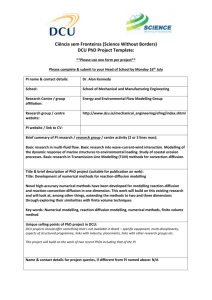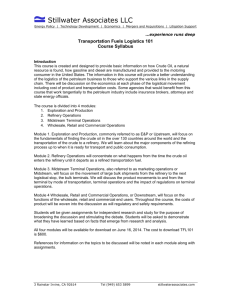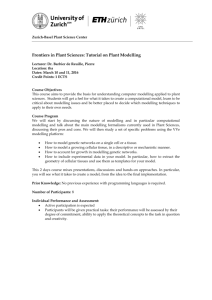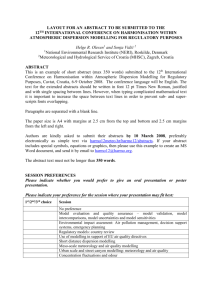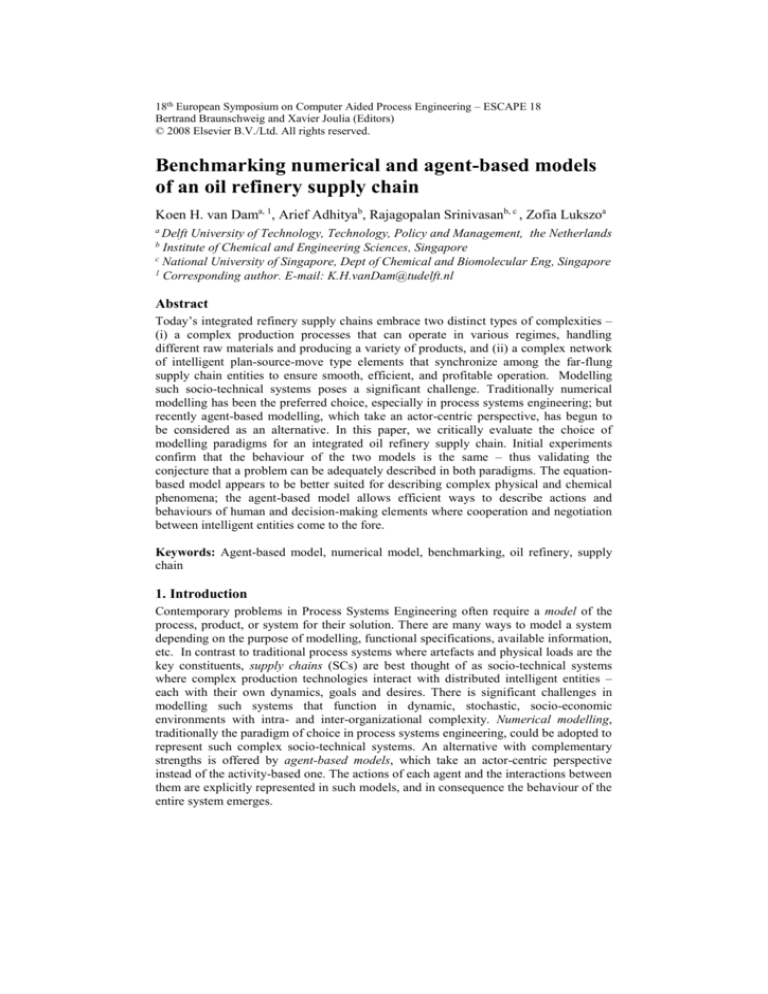
18th European Symposium on Computer Aided Process Engineering – ESCAPE 18
Bertrand Braunschweig and Xavier Joulia (Editors)
© 2008 Elsevier B.V./Ltd. All rights reserved.
Benchmarking numerical and agent-based models
of an oil refinery supply chain
Koen H. van Dama, 1, Arief Adhityab, Rajagopalan Srinivasanb, c , Zofia Lukszoa
a
Delft University of Technology, Technology, Policy and Management, the Netherlands
Institute of Chemical and Engineering Sciences, Singapore
c
National University of Singapore, Dept of Chemical and Biomolecular Eng, Singapore
1
Corresponding author. E-mail: K.H.vanDam@tudelft.nl
b
Abstract
Today’s integrated refinery supply chains embrace two distinct types of complexities –
(i) a complex production processes that can operate in various regimes, handling
different raw materials and producing a variety of products, and (ii) a complex network
of intelligent plan-source-move type elements that synchronize among the far-flung
supply chain entities to ensure smooth, efficient, and profitable operation. Modelling
such socio-technical systems poses a significant challenge. Traditionally numerical
modelling has been the preferred choice, especially in process systems engineering; but
recently agent-based modelling, which take an actor-centric perspective, has begun to
be considered as an alternative. In this paper, we critically evaluate the choice of
modelling paradigms for an integrated oil refinery supply chain. Initial experiments
confirm that the behaviour of the two models is the same – thus validating the
conjecture that a problem can be adequately described in both paradigms. The equationbased model appears to be better suited for describing complex physical and chemical
phenomena; the agent-based model allows efficient ways to describe actions and
behaviours of human and decision-making elements where cooperation and negotiation
between intelligent entities come to the fore.
Keywords: Agent-based model, numerical model, benchmarking, oil refinery, supply
chain
1. Introduction
Contemporary problems in Process Systems Engineering often require a model of the
process, product, or system for their solution. There are many ways to model a system
depending on the purpose of modelling, functional specifications, available information,
etc. In contrast to traditional process systems where artefacts and physical loads are the
key constituents, supply chains (SCs) are best thought of as socio-technical systems
where complex production technologies interact with distributed intelligent entities –
each with their own dynamics, goals and desires. There is significant challenges in
modelling such systems that function in dynamic, stochastic, socio-economic
environments with intra- and inter-organizational complexity. Numerical modelling,
traditionally the paradigm of choice in process systems engineering, could be adopted to
represent such complex socio-technical systems. An alternative with complementary
strengths is offered by agent-based models, which take an actor-centric perspective
instead of the activity-based one. The actions of each agent and the interactions between
them are explicitly represented in such models, and in consequence the behaviour of the
entire system emerges.
2
K.H. van Dam et al.
In this paper, we critically evaluate the choice of modelling paradigms for an integrated
oil refinery SC. The two different modelling approaches will be compared with a view
to identifying their relative strengths and weaknesses. Benchmarking is performed to
identify the role best suited for each. The rest of this paper is structured as follows.
Section 2 describes the benchmarking process and the performance indicators, followed
by the refinery case study in Section 3. Section 4 discusses the numerical and agentbased models, which are used to conduct a comparative experiment in Section 5.
Section 6 concludes with lessons learnt from the benchmarking exercise.
2. Benchmarking process
Benchmarking is about making comparisons and through these, learning generalisable
lessons. It is not possible to compare modelling paradigms based only on the conceptual
model specifications; rather a well-defined benchmarking process is required.
In order to assess the performance of the two modelling paradigms, the following
scheme is suggested (Monch, 2007):
1. Definition of the objectives for the study
2. Determination of what is to be benchmarked (the object of the study)
3. Determination and specification of performance measures
4. Description of scenarios (well-structured experiments) that should be simulated
5. Simulation and discussion of the results with recommendations
The objective of the study, as said in the Introduction, is the comparison of the two
modelling paradigms. The objects of the study are two models of a refinery SC. To
determine the performance measure for both ways of modelling it is essential, besides
comparison of the outcomes, to also reflect on the modelling exercise as a whole. For
instance, it is now widely accepted that the ease of developing the model and
maintaining it over the lifespan of the application is an important (sometimes critical)
determinant in successful industrial acceptance. Therefore, in addition to comparing the
numerical simulation results from the two models, we also look at other qualitative key
performance indicators.
Cavalieri (2007) describes a benchmarking service for different users of control systems
(e.g., researchers, vendors as well as practitioners from the industry). There
performance is evaluated in terms of efficiency, robustness and flexibility. We use the
same indicators here. Considering efficiency, we will look at the ease of expressing the
problem in each modelling paradigm. For robustness, the possibility of extending the
models can be compared and for flexibility their re-usability. Inspired by the work of
Cavalieri, an additional performance indicator is formulated: the ease of explaining the
model and its applicability.
3. Case study: Integrated refinery supply chain
A typical refinery SC comprises crude oil suppliers, 3rd party logistics providers (3PL),
shippers, jetty operators, the refinery and customers. The refinery occupies a pivotal
position in the SC with its functional departments initiating and controlling the
interactions with the external entities for the various SC activities. Crude procurement is
managed by the procurement department, which interacts with the sales department to
get demand forecasts, the operations department to confirm crude suitability, and the
logistics department to arrange crude transport before ordering from a supplier. Crude is
typically transported in a very large crude carrier (VLCC). The storage department
manages the crude unloading from VLCC to crude tanks via pipeline or jetty.
Benchmarking numerical and agent-based models of an oil refinery supply chain
3
The operations department is responsible for supervising the transformation of crudes
into various products through the refining operations such as distillation, reforming,
cracking, isomerisation and product blending. The operations department decides the
throughput and production mode and requests the release of crudes from storage. Each
production mode maximizes the yield of a specific product and has an associated recipe,
(i.e. the ratios of the various crudes). The sales department provides actual demand
information to the storage department to release the products for delivery. A maze of
complex interactions between the different entities and resulting decisions ensure the
orderly and efficient functioning of the supply chain as described in detail by Julka et al.
(2002). There combined performance determines the economics via crude costs, product
prices, operation costs, transportation, etc.
4. Integrated refinery supply chain modelling
Two dynamic models of the supply chain have been developed: a numerical model and
an agent-based one. Despite the differing paradigms, the models share the same
assumptions and model boundaries. Both models explicitly consider the various SC
activities mentioned above. Both models use the same values for parameters such as
production recipes and yields, capacities of storage and throughput, mean demands,
crude prices, variation percentages, etc.
4.1. Numerical model
The SC entities and operations described in Section 3 have been modelled as a blockbased simulation (Pitty et al., 2007) and implemented in Matlab/Simulink (MathWorks,
1996). Four types of entities are incorporated in the model: external SC entities (e.g.
suppliers), refinery functional departments (e.g. procurement), refinery units (e.g. crude
distillation), and refinery economics. Some of these entities, such as the refinery units,
operate continuously while others embody discrete events such as arrival of a VLCC.
Both are considered using a unified discrete-time representation.
The model explicitly captures the various SC activities such as crude oil supply and
transportation, along with intra-refinery SC activities such as procurement planning,
scheduling, and operations management. Stochastic variations in transportation, yields,
prices, and operational problems are considered. The model allows the user the
flexibility to modify not only parameters, but also replace different policies and
decision-making algorithms in a plug-and-play manner through ‘m’ files.
4.2. Agent-based model
The agent-based (AB) model is based on a generic ontology for socio-technical systems
(van Dam and Lukszo, 2006) and Java building blocks that have previously been used
in other infrastructure case studies, such as intermodal freight transport
(Sirikijpanichkul et al., 2007), CO2 emission trading (Chappin et al., 2007), and
industrial clusters (Nikolic et al., 2007).
All the instances of the model components, including the agents and all technical
components (e.g., refinery units, jetty, etc) and their links (e.g., pipeline between the
jetty and the crude storage tank) have been stored in a Protégé knowledge base, which
can be changed without having to adjust the model source code, which works
independently. For physical components possible in and out flows are defined, along
with certain other properties. Furthermore, the ontology contains concepts such as
'transport contract' and 'physical flow' which are instantiated during the model run.
The agents in the model all act autonomously according to their own goals. A schedule
is made so that some processes (e.g., procurement) only occur at certain intervals while
others (e.g., production) happen each time step of the model. Events such as the arrival
4
K.H. van Dam et al.
Crude Stock
1600
Crude Stock (kbbl)
1400
1200
1000
Crude 1
800
Crude 2
Crude 3
600
Crude 4
Crude 5
400
200
0
0
20
40
60
80
100
120
Day
Figure 1. Base case for crude inventory and production profiles from the numerical model
of a VLCC at the jetty are continuously monitored. Agent negotiation about trade and
transport is formalized in contracts, providing a natural representation of the problem.
This agent-based model is implemented in Java using the Repast agent simulation
toolkit (North et. al, 2006).
5. Experiments
To assess the validity and similarity of the two modelling paradigms for the current case
study, the model predictions for a base-case scenario are first compared. Other scenarios
have also been identified but are not elaborated here due to space constraints. The basecase considered the operation of the integrated refinery supply chain over a period of
120 days. Both models reflect the specification data and parameters reported in Pitty et
al. (2007).
The model predictions show that both modelling paradigms result in very similar
behaviour of procuring and processing crudes. One visible indication of this is from the
evolution of the various crude inventory levels (compare Figures 1 and 2). Given the
numerous stochastic effects in the models, it is natural that the two profiles do not
coincide exactly. For instance, the underlying random number generators in Matlab and
Java do not result in the same sequence of random numbers. These platform-dependent
quirks will however be overcome though our ongoing work and enable more precise
comparisons of the model outcomes. However, overall the experiment confirms that the
behaviour of the two models is the same, validating the conjecture that the supply chain
can be adequately described in both paradigms.
6. Evaluation and conclusions
Our preliminary results from model development and base case scenario are reported
next. More scenarios are being currently studied to draw further insights about the
Benchmarking numerical and agent-based models of an oil refinery supply chain
5
relative advantages of the two paradigms, but some initial conclusions can already be
drawn. Here the four performance indicators from Section 2 are revisited:
1. Ease of expressing the problem in each modelling paradigm. Any supply chain
contains two distinct types of elements – production processes (technological system)
with complex physical and chemical phenomena, and decision-making / business
processes involving inter-entity collaboration (social system). The behaviour of the
former is best described through equations and the latter through rules. The numerical
model caters well to the equation-oriented aspects. The agent-based model has lesser
expressive breadth for these, but offers instead a rich vocabulary for describing
business processes and rules. For example, limitations to transfer of crudes from the
jetty to the storage tank or including hold-ups in the pipes was easily addressed in the
numerical model but more complicated in the AB model. On the other hand, the role
of the 3PL and the negotiations between various shippers are easily represented in the
agent-based model.
2. Ease of extending the models. From our current studies, the two paradigms appear
comparable in this aspect. For example to incorporate a new procurement strategy in
the numerical model, a new equation to calculate crude procurement amount was
needed. In the AB model, this can be addressed by changing the behavioural rules of
the procurement department to include a request to the storage department to provide
up to date data on stocks. This additional term was then added to the equation to
determine the new amount.
3. Ease of re-use. The AB paradigm provides a hierarchical framework to describe the
model constituents. In this work, a key part of the model – the ontology – was
derived from earlier modelling efforts in other domains. The use of a generic
ontology makes re-use easier and also allows connections to other models, for
example one of an industrial cluster incorporating other chemical industries where
other agents could become consumers of the refinery. The numerical model does not
enforce any such structure, hence reusability is in general difficult especially across
different modellers.
Figure 2. Base case for crude inventory and production profiles from the AB model
6
K.H. van Dam et al.
4. Ease of explaining the model. As stated by Van der Zee (2006), “a fundamental
challenge in simulation modelling of manufacturing systems is to produce models
that can be understood by the problem owner”. The explicit hierarchical structure in
the agent-based model also enables a natural representation for behaviours, both in
terms of organization and visualization; mostly, this is harder with a set of equations.
It is important to stress that the current study is an initial part of a larger, more
comprehensive effort to map the relative merits of the two modelling paradigms. The
agent-based and numerical approaches have complementary strengths because they can
be used for different operational schemes with minimal customization.
In our on-going and future work, we will include further refining the two models to
address more detailed issues to evaluate how they capture various aspects of the
problem. Furthermore, we are working on addressing the important issues of
quantifying efficiency, robustness and flexibility by involving an expert panel to
evaluate the modelling paradigms.
Our future work will also concentrate on approaches to re-use model components and
modelling results across applications. This would eliminate modelling expertise on the
part of the user and enable a new breed of applications where the developer does not
have to be a rate-limiting conduit between decision makers and models.
References
S. Cavalieri, M. Macchi, P.Valckenaers, 2003, Benchmarking the performance of manufacturing
control systems: design principles for a web-based simulated testbed, Journal of Intelligent
Manufacturing, 14(1), pp. 43–58
E. Chappin, G. Dijkema, K.H. van Dam, Z. Lukszo, 2007, Modeling strategic and operational
decision-making – an agent-based model of electricity producers, The European Simulation
and Modelling Conference 2007
K.H. van Dam, Z. Lukszo, 2006, Modelling Energy and Transport Infrastructures as a MultiAgent System using a Generic Ontology, 2006 IEEE SMC, Taipei, Taiwan
N. Julka, I. Karimi, R. Srinivasan, 2002, Agent-based supply chain management – 2: a refinery
application, Computers and Chemical Engineering, 26(12), pp. 1771-1781
MathWorks, 1996, Using Simulink: Version 2
L. Monch, 2007, Simulation-based benchmarking of production control schemes for complex
manufacturing systems, Control Engineering Practice, 15, ,pp. 1381–1393
I. Nikolic, G.P.J. Dijkema, K.H. van Dam, 2007, Understanding and shaping the evolution of
sustainable large-scale socio-technical systems towards a framework for action oriented
industrial ecology. In: M. Ruth and B. Davidsdottir (Eds.) The Dynamics of Regions and
Networks in Industrial Ecosystems, Edward Elgar (In Press)
M.J. North, N.T. Collier, J.R. Vos, 2006, Experiences Creating Three Implementations of the
Repast Agent Modeling Toolkit, ACM Transactions on Modeling and Computer Simulation,
16(1), ACM, New York, USA, pp. 1-25
S. S. Pitty, W. Li, A. Adhitya, R. Srinivasan, I. A. Karimi, 2007, Decision Support for Integrated
Refinery Supply Chains. 1. Dynamic Simulation, Computers and Chemical Engineering (In
Press)
A. Sirikijpanichkul, K.H. van Dam, L. Ferreira, Z. Lukszo, 2007, Optimizing the Location of
Intermodal Freight Hubs: An Overview of the Agent Based Modelling Approach, J. of
Transportation Systems Engineering & Information Technology, 7(4), pp 71-81
D.J. Van der Zee, 2006, Modeling decision making and control in manufacturing simulation.
International Journal of Production Economics, 100(1), pp. 155–167.


